This is a Pentacon FM 35mm SLR made by VEB Zeiss-Ikon Dresden in East Germany between the years of 1958 and 1961. This camera is part of the Contax S series which debuted in 1949 as the first German built SLR camera with a fixed pentaprism viewfinder. It is identical to the Contax FM with the only difference being Contax models were sold within East Germany, and Pentacon models were exported everywhere else. It uses the M42 screw mount, has a cloth focal plane shutter, and an automatic diaphragm. The Pentacon/Contax FM differs from the earlier F model in that it has a large split image focus aide in the viewfinder. The layout and design of the entire Contax S series set the standard for how almost every SLR that would follow it would be designed and is one of the most historically significant cameras ever made.
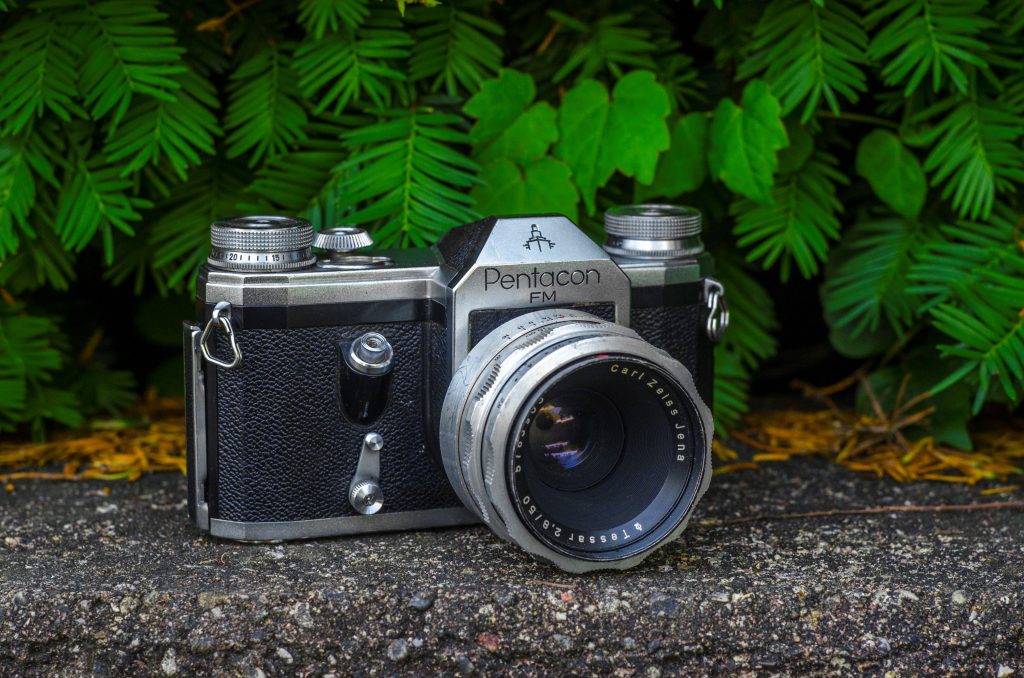 Film Type: 135 (35mm)
Film Type: 135 (35mm)
Lens: 50mm f/2.8 Carl Zeiss Jena Tessar coated 4-elements + others
Lens Mount: M42 Screw Mount
Focus: 1.65 feet to Infinity
Viewfinder: Fixed SLR Pentaprism
Shutter: Cloth Focal Plane Shutter
Speeds: B, 1 – 1/1000 seconds
Exposure Meter: None
Battery: None
Flash Mount: PC Port M and X Flash Sync
Manual: http://www.cameramanuals.org/pdf_files/pentacon_f.pdf
My Final WordHow these ratings work |
The Pentacon FM is a perfect example of the workmanship, quality, and design of German cameras from the 1950s. Zeiss nailed the design perfectly with the very first Contax SLR and it only got better from there. This camera, despite its age shoots like one made decades later. It uses the ubiquitous M42 lens mount so there are literally millions of lenses made that will work with it. Although it can be hard to find one in good working order, the camera is a joy to shoot, looks great hanging from a strap around your neck, and is capable of excellent images. This camera may not have the modern niceties of a 1980s Nikon, but it is one heck of a camera, and a lot of fun to shoot. I will come back to this camera many times over compared to more capable cameras made later. | ||||||
| Images | Handling | Features | Viewfinder | Feel & Beauty | History | Age | |
| 2 | 2 | 1 | 2 | 2 | 1 | 30% | |
| Bonus | +1 for overall awesomeness, the complete package | ||||||
| Final Score | 14.0 | ||||||
The name Zeiss has been recognized as a brand of quality German optics for well over a century. The company still exists today as Carl-Zeiss-Stiftung, or Carl Zeiss Foundation in English. It is the parent owner of Carl Zeiss AG who is still a leader in the optics industry, making a wide variety of optical systems, industrial measurements, and medical devices. The company’s history is extremely complex, consisting of many mergers, separations, splits, and other various changes along the way.
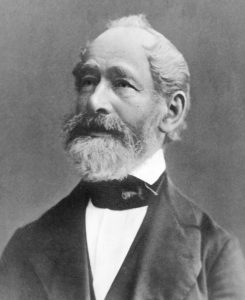
Originally founded in 1846 by physicist and mathematician Carl Zeiss as Carl Zeiss Jena, its first products were microscopes and other scientific instruments. The name “Jena” refers to Jena, Germany, a small town in central Germany, located approximately 260 km southwest of Berlin, where Zeiss was headquartered.
Over the course of the next 90 or so years, Zeiss would become a world wide leader in optics design, creating some of the most successful lens formulas such as the 4-element Tessar and 6-element Planar. Variants of these original lens formulas are still used today, and are the most widely copied lens designs ever created.
Prior to the 20th century, Zeiss was exclusively an optics company, making lenses for other companies to use in their cameras. Zeiss wouldn’t make its own camera until around 1900 with the release of their Palmos series.
The early 20th century was a period of huge growth for the German camera industry with companies popping up with regularity all over the country. Many of these companies formed in or around the eastern city of Dresden. Dresden became the unofficial center of the photographic industry with over a dozen companies all competing in the camera and optics industries.

After the first world war, the German economy was in shambles and many of the medium to smaller companies found it difficult to stay in business. Many of them folded, but in 1926, four different Dresden based camera makers would all merge together with an infusion of capital from the Carl Zeiss Foundation to form an all new company, known as Zeiss-Ikon. The four companies that would make up this new company were Contessa-Nettel AG, Erneman, Goerz, and ICA (who themselves were a previous merger of 4 different companies).
Located in Dresden, Zeiss-Ikon would combine the resources, experience, and current models of the 4 companies that it consisted of selling many of them under the Zeiss-Ikon name. As a unified company, Zeiss-Ikon would survive the poor Germany economy and would become a worldwide leader in the camera industry.
After World War II, Germany would be split into two halves, West and East Germany. Since Dresden was located in the eastern side of the country, it would fall under Soviet control. The town of Jena, Germany, where the Carl Zeiss Foundation’s headquarters was located, was incorporated into the Soviet Occupation Zone and would eventually become part of East Germany as well. As a result, many of the employees from the Jena factory were relocated to locations in Oberkochen and Stuttgart, in Allied controlled West Germany.
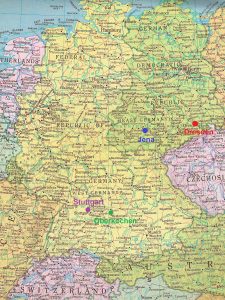
This caused a number of legal and political challenges between the two halves of Germany and the very different ideologies of its governments. It would take a few years for the political and legal issues to be resolved as to who owned the names, trademarks, and technology of the Zeiss brand, but in 1946 there would be two Zeiss companies. In West Germany, a new company called Zeiss-Opton Optische Werke Oberkochen GmbH (later renamed back to Carl Zeiss Foundation in 1947) was created, and the newly formed VEB Zeiss-Ikon Dresden would become a state owned entity and remain in Dresden. The abbreviation VEB stands for Volkseigener Betrieb which translates to ‘Publicly Owned Operation’ in English and was the main legal form of industrial enterprise in East Germany from the late 1940s until the early 1960s.
One of the outcomes of these lawsuits was that VEB Zeiss-Ikon Dresden would lose the rights to use the name Contax which was the name of a highly successful line of rangefinders that was developed by Zeiss-Ikon in the 1930s. The technology and design of the Contax rangefinder however would be owned by the Soviet government and production would be shifted to Ukraine and sold as the Kiev rangefinder.
Around 1939, Zeiss-Ikon had begun work on an all new pentaprism based single lens reflex camera that would eventually be given the Contax name, but the camera was never completed. Prototype mockups and drawings exist, but I do not believe any were actually made. During the war, design for this new camera was put on hold and nothing came of it until 1948 when the design work was resumed by VEB Zeiss-Ikon Dresden for a new model.
The design of the new SLR was headed by two men named Wilhelm Winsenburg and Walter Hennig who debuted an early prototype in 1948 at the St. Erik Fair in Stockholm, Sweden. In March 1949, another prototype, now called the Contax S debuted at the Leipzig Spring Fair in East Germany.

In defiance of their loss of the Contax trademark, VEB Zeiss-Ikon Dresden would call their new SLR the Contax S anyway. The camera would be sold with a Contax name in East Germany only, but the company would be forced to use the name Pentacon everywhere else. The name Pentacon is a combination of the words PENTAprism and CONtax. Pentacon labeled cameras are identical in every way to their Contax counterparts, other than the name. The Contax S would spawn over a dozen different variants and would be in production until the early 1960s. The practice of calling East German models Contax, and Pentacon everywhere else would continue throughout the series’s entire run.
The Contax S set the standard for the design and ergonomics of SLR cameras for the rest of the world. It had a classic design that modern DSLR cameras still take cues from today. The signature feature of course was the pentaprism viewfinder which allowed photographers for the first time to view their subject through the lens in an upright and correct orientation. Its focal plane shutter was capable of speeds as fast as 1/1000 second and it used the new M42 screw mount that first appeared on the KW Praktiflex from 1948.
The Contax S would be replaced by the Contax/Pentacon D in 1952 and would improve upon the original model’s build quality resulting in a much more reliable camera. None of the later Contax/Pentacon models would significantly change the original design, but would rather offer incremental improvements such as a self timer, support for automatic diaphragm lenses, brighter viewfinders with split image focus aides, and even light meters.
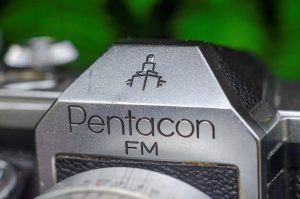
All Pentacon models would feature the “Ernemann Tower” logo on the top of the pentaprism, but the Contax S and D models made prior to 1953 would still feature the old Zeiss-Ikon logo. Starting in 1953, the Zeiss-Ikon logo would no longer used, and all Contax and Pentacon models would feature the tower logo. When it was completed in 1923, the Ernemann Tower was Germany’s tallest building and the home office of the Ernemann camera company in Dresden. As the company changed hands, the Ernemann tower continued to be operated by Zeiss-Ikon and eventually VEB Zeiss-Ikon Dresden.
The Contax/Pentacon FM being reviewed here was released in 1958 and offered only one new feature, which was a large split image focus aide in the viewfinder.
The entire Contax/Pentacon series sold well. According to Mike’s Praktica Collection, a total of 187,000 Contax/Pentacon cameras were built between September 1949 and March 1962. It was exported all over the world under a variety of names such as Hexacon, Astraflex, Consol, Super-D, and a few others.
Today, the entire Contax S series and its variants are highly collectible for their history, design, and performance. Some collectors will specifically target the entire series, owning one of each model. While the Nikon F of 1959 was a hugely successful camera that helped turn the tide in favor of the SLR for professional photographers, it didn’t have a lot of firsts. Many of the Nikon’s features were based off things that the Contax/Pentacon SLRs already had.
As a result of its reputation, these cameras can fetch pretty high prices on the used market. Early examples in good working condition can sell for several hundred dollars. Many were made however, so there are bargains to be had if you look hard enough.
My Thoughts

I think the Contax/Pentacon SLRs are some of the best looking cameras ever made. They have a design that’s both classic and modern at the same time. The general layout of one of these cameras is not unlike SLRs made decades later. Sure, they have a few differences that show their age like the knob wind, and the unique shutter speed selector, but otherwise, the general shape and layout of the controls is where they are still today.
I first saw a Pentacon SLR in an estate sale about a year and a half ago. It was in terrible shape, and I didn’t know enough about it to warrant picking up. This was a decision that I would later regret as it was a handsome model that I wished was in my collection.
Finding a worthy Pentacon on a tight budget like I have is not easy as these cameras typically go for pretty high prices, but they also often suffer form a variety of shutter ailments. Pinholes, tears, cracks, and inoperable curtains are very common, not just with these cameras, Ihagee Exaktas, Foth Derbys, and pretty much any camera that uses a similar cloth focal plane shutter are more often to have condition issues. So when one does come up for sale in good working condition, the prices are often justifiably high.
As fate would have it, I would have an opportunity to add one to my collection within a lot of cameras from a seller in Lithuania that included uncommon models like the Pouva Start and the VEB Kinowerke Dresden Penti II. The camera was sold body only and didn’t have a lens, but knowing it used the standard M42 lens mount, I figured I could use one of my many Pentax Takumars with it. I was able to negotiate a package deal including combined shipping for the Pentacon that brought its price down to where I was willing to take a chance.
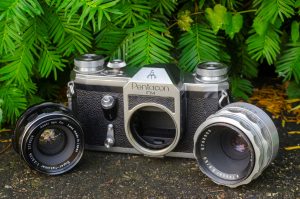
When it arrived, I was elated at the condition of the camera. This Pentacon was unlike any I had ever seen. It was in perfect shape. The curtains looked brand new, the shutter speeds all worked, even down to one second, and the viewfinder had minimal dust in it. The only signs of use this camera had were a couple nicks and scratches on the body, but that’s it. I mounted an Asahi Super Takumar 35/3.5 lens to it and confirmed everything was working perfectly!
The Pentacon looks great in pictures, but it looks even better in person and even though I thought I would be ok to “settle” with the Japanese lens on it (I don’t think it is right to say that you are ever settling when shooting with a Super Takumar lens), I really wanted to get a period correct Zeiss lens for this camera. Most Pentacons were sold with an aluminum bodied 50/2.8 Tessar lens. The Pentacon FM was one of the first SLRs to support an automatic diaphragm, so I had to be sure to find one with that little pin in the mount to support this feature.
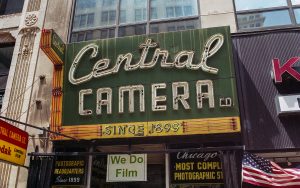
Around Father’s Day 2017, I met up with fellow collectors Mark Faulkner and Johnny Sisson at Central Camera, in Chicago, IL, and I brought my Pentacon with me. While browsing through the store I had asked if they had any Zeiss lenses that were period correct for my camera and upon looking through the various bins and boxes in the store, none were found.
Later in my visit, Johnny asked if I would like a tour of the basement. I thought “a tour in the basement of a 118 year old camera store….HELL YES!!!”
The basement of Central Camera was as awesome as I had hoped it would be. Boxes upon boxes of old camera parts as far as the eye could see! Although I respected the owner’s wishes to not rummage too much down there, it was hard to not spend the rest of the day just looking at the various boxes worth of cameras and other parts, some of which had likely been down there longer than I have been alive.
Upon one quick look on a shelf, what do I see? But an aluminum bodied Zeiss Tessar 50/2.8 lens in M42 mount with an automatic diaphragm! Seriously, it could not have been more perfect timing as this was the exact lens I had hoped I would find! The lens has a serial number of 5,7xx,xxx which suggests it was made in the very late 1950s, when the FM was in production. I was told the lens was in a junk box and all I had to do was make an offer to the owner. $12 later and the lens was mine! It was a tad stiff, but working through it revealed the lens worked perfectly. It had minimal signs of use on the outer barrel, but the glass was clean and free of fungus! I happily screwed it onto the camera and admired it for all of its beauty!
A note about this style of Zeiss Tessar with the automatic diaphragm is that the aperture ring is spring tensioned and is a “pre-set” design. This means that if you want to choose any aperture size other than f/2.8, you must pull “inward” on the ring, then rotate it to your chosen aperture size and then set the ring by pushing it forward again. This leaves the aperture wide open for maximum brightness when composing your image, and tensions an internal spring that will instantly stop down the iris upon pressing the shutter release. After every cycle of the shutter, you must reset the iris each time you want to stop it down. It is difficult to explain in words, but if you ever handle one of these, play with it, and you should figure it out.
The Pentacon FM is surprisingly small and compact, considering its age. It compares favorably in size to the Pentax S-series including the Spotmatic. It has a low profile pentaprism and is smaller and lighter than a Nikkormat FTn or Canon EF SLR from the 1970s. This is likely due to not having any electronics of any kind of in the camera, but nevertheless, it would take a couple of decades before typical 35mm SLRs would once again be as small as the Pentacon was.
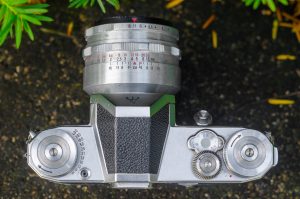
Looking at the top plate of the camera from left to right, the wind knob is large and works exactly how you would expect it to. There is a film reminder collar around the bottom edge with numbers along the top plate from 6 to 400 to help you remember what film is loaded in the camera.
Next to the wind knob is the PC flash sync port. The manual for the Pentacon says that the camera works with “ordinary flash units” and electronic flashes. I assume this means M and X flash sync, but there is no switch or setting anywhere on the camera to set this. I had difficulty even determining the flash sync speed of the camera based on the table in the manual as it does not read like most camera manuals I am used to seeing. I gather that with some flashes the recommended shutter speed is 1/10 or longer, but in some cases you can use up to 1/50. I have no experience with flashes on cameras this old, so I won’t comment further other than to say, I don’t see myself ever trying to use this camera with a flash!
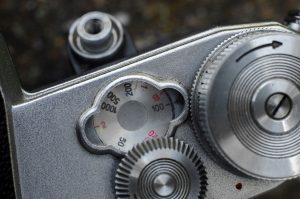
To the right of the viewfinder is the shutter speed selector. This system is unique to these Contax/Pentacon cameras and for someone not familiar, requires a bit of an explanation. Like most cameras of the era, the slow speeds are selected independently from the fast speeds. The shutter speed dial is beneath a glass plate and has two “ears” on each side that indicate the slow speeds (1 – 1/20 and Bulb) in red, and the fast speeds (1/50 – 1/1000) in black. There is a separate switch on the back plate of the camera to the right of the eyepiece which is used to select between the slow and fast speeds. If the switch is to the left, the slow speeds are selected, and a red arrow will appear in the left “ear” of the speed selector. Move the switch to the right, and the fast speeds are selected, and a black arrow will appear in the right “ear”. In the image to the right, the black arrow is in the right ear, indicating the camera is set to 1/100. On my camera, this switch required a bit of force to move. I am not sure if that’s normal, or if it is a symptom of old age, but moving it had no ill effects on the camera, so maybe it is normal.
To change the selected speeds, you push down and rotate the raised round knob with the knurled edges. There is a counter-clockwise arrow on this knob that indicates the proper direction to turn it. According to the manual, if the shutter is not cocked, you must turn this knob counter-clockwise, but if you cock the shutter, you can turn this knob in either direction. To be safe, I just always turned it counter-clockwise in the direction of the arrow.
Finally, on the far right side of the top plate is the winding knob. Like most knob-wind cameras, you grip this with your right hand and turn clockwise until it stops. The Pentacon FM does not have an “instant-return mirror” which means that winding this knob also lowers the mirror so that you can see through the viewfinder. After each exposure, the mirror remains up, blocking light from entering the viewfinder.
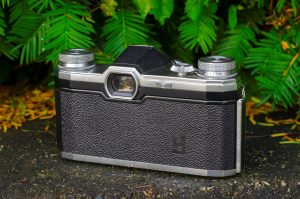
The back of the camera is clean, and other than the fast/slow switch and viewfinder, the only thing you see is some kind of classy logo embossed into the leatherette. I do not recognize the symbol, but if I find out what it is, I will update this review.
Edit 5/10/2022: Since posting this review, several readers have commented that the symbol on the back of the camera is a quality mark, which according to dresdner-kameras.de says “Product of outstanding quality, embodies the scientific and technical peak at the time of award, corresponds to comparable top products of the world market”. Thanks Martin and Geert!
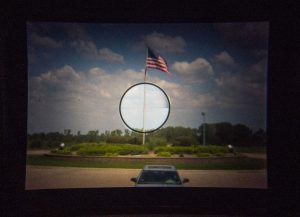
Regarding the viewfinder, it is very large and bright, especially for the age of the camera. While it won’t compare to a camera from the 1980s with a laser cut Fresnel pattern, the viewfinder is brighter and more useful on the Pentacon FM than many other SLRs from the 1950s and 60s. In addition, the “M” in the model name “FM” means that this model has a very large and bright split image focus aide which is incredibly useful for me as my poor vision causes me to struggle with traditional ground glass and microprism focus aides.
The rest of the camera is pretty standard fare for an SLR from the era. The shutter release is comfortably at an angle on the front of the camera and is threaded for a cable release. I have always found these angled front shutter releases to be more comfortable than top shutter releases, yet, I have never found a conclusive explanation as to why they eventually disappeared.
There’s a self-timer beneath the shutter release that works like every other self-timer of this design. Rotate the lever counter-clockwise as far as it will go and upon pressing the shutter release, the lever will slowly begin rotating clockwise, and then after about 10 seconds, the shutter will fire.
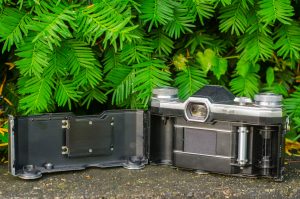
Opening the film back is unique only in that the hinge is on the left side of the camera, instead of the right. A new cassette loads on the left side of the camera and the fixed take up spool is on the right. The Pentacon has very deep door channels so no light seals, yarn or otherwise, are needed. The edges of the door have a black velvet like material that was still in good shape on my example and did not need replacing.
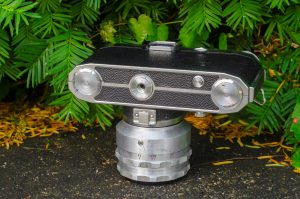
The bottom of the camera is pretty basic. There is a tripod mount in the center, a small rewind button on the right side of the bottom, and immediately beneath the lens mount is a folding kickstand that can help support the camera body when using a heavy lens.
I’ve probably spent an inordinate amount of time describing the use and cosmetics of this camera, because I really hope that anyone reading this review can understand how well it is designed. From a functional standpoint, sure, a wind lever would be easier, and the separate settings for slow and fast shutter speeds is a little outdated, but otherwise this camera is a pleasure to use. This is even more so significant considering how old it is. I love the Ihagee Exakta, but that camera is practically the polar opposite of how this camera is designed. Anyone who has ever used an SLR could be given a 30 second crash course on this camera and be an expert on their first roll.
In addition to all of the usability and ergonomic praise I have for this camera, I think this camera is absolutely gorgeous! This has to be one of the best looking SLRs in my entire collection! For everything great I can say about the Nikon F, it is one of the most historically significant cameras ever made, but it is an exercise in Japanese “function over form” design. The Pentacon is function AND form!
It should probably be pretty obvious at this point what I think of this camera. Of all of the cameras in my collection, this is a top 10, maybe even top 5 for me. If I had to sell off parts of my collection, this would be one I would hold onto. The fact that I got it in such great cosmetic and perfect working condition is not something that’s repeatable, so for all of the hype I’ve given this camera, I realize that duplicating my luck would be incredibly difficult for someone else. All I can say, is that if you ever have an opportunity to buy one of these, maybe a Contax variant, and it is in good working condition, buy it…at any price. It is worth it!
My Results
I had fallen in love with the Pentacon FM the moment I got it. Initially I thought I would be satisfied with the Pentax lens mounted to it, but I quickly realized that this was a camera worth completing. Once I attached the period correct Zeiss Tessar, my affinity for the camera grew.
I shot my first roll of film while walking around Chicago and most of the images were done with the Tessar. The longer I used the Pentacon, the more I liked it. Sure, its a bit primitive, but like the Nikon F, this was a highly influential camera in terms of camera design and functionality, so despite its age, it shoots like a much newer camera.
I predicted this would become one of my favorite cameras, but the only thing I didn’t yet know was how the images would come out.
Every image from my inaugural roll through the Pentacon was sharply in focus and exposed properly. The only criticisms of some of the images are in my own composition as I am not a very good photographer.
It is a testament to the quality and effort of the German technicians who built this camera and its lens. The images all came out wonderfully, and the camera still works likely as good as it did the day it rolled off the assembly line. I have no way of knowing for sure how accurate the shutter speeds are, but it is clear that they’re close enough as I shot the entire roll using Sunny 16. Even shots done in the full shade of Chicago’s skyscrapers are exposed well. It is no surprise that the Tessar lens shows no signs of vignetting, chromatic aberrations, softness, or any other optic anomalies. There is a reason this lens formula has been copied time and time again.
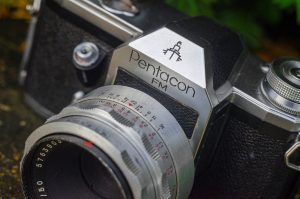
One of my favorite things about this hobby is when I shoot an old camera, I can’t help but wonder what other things this camera has seen. Who was its original owner? Where did he or she live? How many times has it changed hands? How long has it been since the camera last made any new images? With rare exception, you’ll likely never find the answers to these questions. I know for sure this body came to me from Lithuania, and the lens had spent considerable time in Central Camera’s basement, so the stories each part could tell if it could talk must be very interesting. Fate would bring these two pieces together, nearly 60 years after both the body and lens were made, and I would be the one to put a new roll of film in it and allow the camera to once again make photographs.
I realize that non-camera people probably roll their eyes at the sentiment that there’s anything fundamentally special about a classic camera, but for those of you who get it, you know what I’m talking about. Maybe this camera never photographed anything spectacular, or was owned by a homebody who never took it anywhere, but maybe it did, and that’s the exciting part. This is a special camera and I am so happy that I have it and am able to share what little I know about its story with you.
Related Posts You Might Enjoy
External Links
http://www.praktica-collector.de/105_Pentacon_FM.htm
http://www.pentax-slr.com/108413507
http://camerapedia.wikia.com/wiki/Contax_S
http://retinarescue.com/pentaconfm.html
http://captjack.exaktaphile.com/praktina/Contax-Pentacon%20Cameras.htm


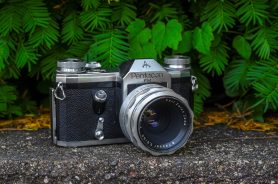









Great article Mike, and I am green with envy at you finding one in such great condition. I totally get what you mean about your sentiments about the past of both camera and lens, and the pictures are really sharp. I am not surprised you are so delighted with this acquisition. And don’t worry I too am not a very good photographer at all, so you’re not alone there but I love the look, the feel, the historical significance, and just damn well playing with or working on with these old cameras and lenses. Long may they live on. 🙂
Hi Mike, great review as always. I bought the Contax big D (after much research) for many of the same reasons. I really love the west German Contax but I wear glasses and the small viewfinder was a problem. The big bright finder on the Contax D is a joy to use, and images just pop into focus with ease.
Another reason I chose the Contax (apart from its looks) was the amazing Zeiss lenses that came with it I fell in love with the early aluminium of Alu silver lenses. I have the very rare early black model 58mm f/2 Biotar with 17 blades, famed for its bokeh. A 35mm Flektagon the world’s first commercially available wide angle lens, superb sharp, beautiful Zeiss color rendition and can close focus for macro shots. On the way from Europe is the rare 80mm Biotar portrait lens. But I am yearning after the super-rare 75mm f/1.5 Biotar, one of the best portrait lenses in the world.
This lens is so good that the modern Meyer Optik company have just announced they are making a modern version, despite this being a Zeiss design, and their other lenses being reproductions of East German Meyer Optik lenses.
The Contax S was a revolutionary camera, World’s First Pentaprism SLR Camera and the Grandfather of every modern SLR. It was selected as one of ”The Top 20 Cameras Of All Time” by Jason Schneider, Shutterbug-Magazine, May 1, 2008, and in an earlier article in 2000 he selected it as one of “The 10 most important cameras of the 20th century”.
I found the camera joy to use, and mine also was in mint condition but needed its shutter curtain speed to be adjusted. Mine is being repaired by Brett Rogers in Tasmania, Australia.
Note: This range of cameras is well known for the shutter curtains having pinholes or needing replacement, Rick Oleson has a guide to doing it yourself, if you are game. If not (like me) then there are specialist who can service them quite cheaply.
If anybody wants to buy one of these cameras, or hunting for lenses I can thoroughly recommend Attila Fricz who runs the MFLenses Forum.
http://mflenses.com/
Wow, Cheyenne, what a great reply! I think you did just as good of a job explaining all of the camera’s merits in your one reply as it took me the whole review to do. Hopefully with our combined information, more people will see how truly special these cameras are!
I’ve seen Rick Oleson’s guide, but like you, thats far beyond my skill set. I have only once attempted a curtain replacement on a FED 2, and I failed spectacularly.
Hi Mike! The logo on camera back is combined 1 and Q symbols, which means 1st Quality. You can find the same logo on your Tessar lens.
And… There’s two of these beautiful cameras sitting on my shelf, one Contax S with broken shutter curtains and one Contax D waiting for CLA.
Thank you for your great site I found just couple of days ago, so I’m scrolling through the reviews and articles recently.
Thanks for the explanation of that logo! In my research for this camera, that information somehow eluded me! I will be sure to update the review with an explanation, and Ill be sure to give you credit, of course!
I am glad you are finding my other reviews interesting! I have many more to come!
I also have an FM to replace a D with punctured curtains which didn’t survive my attempts to repair it. I have the original (?) aluminum 50 mm 2.8 Tessar, and couldn’t believe how sharp it was when I ran my first roll through it. The FM’s split-image viewfinder is a great improvement over the D, as are the larger winding knobs.
I also have a SuperTakumar 28 mm f 3.5, and even though it doesn’t “look right” with the German camera, it does take great pictures.
Thanks for your review!
My father bought this camera around 1961 when he was 20 and it has been in the family ever since. She has traveled a lot, seen a lot of the world, at least by East German standards. Her first trip was a cruise on East Germany’s only cruise ship, the “Völkerfreundschaft” (frriendship of the people). Originally it was going to be a voyage through the Mediterranean Sea, but then the Wall was built separating East and West Germany for almost 30 years, and it became a Baltic Sea voyage to St. Petersburg (former Soviet Union, not Florida). After that she was in almost every country in the Eastern bloc, she was in the Danube Delta and (almost) on the summit of the Caucasus mountains, she was in Sochi on the Black Sea, a fashionable bathing resort from the time of the Tsars, came from Berlin to Baku Azerbaijan, and that was quite remarkable.
I then took it over at the end of the 1990s. Among other things, we operate close to Greece, on the island of Santorini. Then I had the mishap that I dropped it when changing lenses and had to get it repaired.
For the next two decades I used a new Canon EOS 500, which with its two lenses together was lighter than just the body of the Pentacon and it had a lot of luxury. But she was made of plastic and her lifetime was very limited.
After a brief foray into digital photography, I am drawn back to my roots, it has now also seen France (the Canon died there) the Pentacon is currently being serviced and will remain in the family for many years to come (my son also has already had an eye on her).
Mike:
You wrote:
“The back of the camera is clean, and other than the fast/slow switch and viewfinder, the only thing you see is some kind of classy logo embossed into the leatherette. I do not recognize the symbol, but if I find out what it is, I will update this review.”
It looks to me like the logo may be a quality mark issued by the German Democratic Republic at the time.
This site, https://www.dresdner-kameras.de/firmengeschichte/guetezeichen/guetezeichen.html, has a table, with illustrations of quality marks, showing a nearly identical mark, described as follows:
Quality mark “Q” (introduction as a quality mark of the GDR on 21.02.1950):
• Product of outstanding quality, embodies the scientific and technical peak at the time of award, corresponds to comparable top products of the world market
• replaces after the new regulation of the quality mark award on 08.09.1960 the quality mark special class
• often found on high-quality watches, microscopes, cameras, lenses, etc.
The only difference I see are the letters “DDR” underneath the logo illustrated in the document, which do seem to be on the camera.
Btw, this site, http://www.dresdner-kameras.de, seems to have a huge amount of information on the camera industry in Dresden.
Geert
Mike: I just noticed that Martin already commented the very same thing about the logo on the back of the camera, back in 2017! Well, hopefully the link proves useful.
Geert
Thanks for all of the information and sorry for the slow response. I have “refreshed” the review, updating some pictures and adding yours and Martin’s information you shared about the quality mark. I appreciate the help!
Hi Mike,
Many thanks for the great article! I just got my hands on an FM myself and was wondering if you ever had any issues turning the shutter speed dial after it’s pushed down. It seems like it’s “catching” on the different speeds as I turn it. As you said above, the slow/fast speed switch also takes a bit of force to actuate in my example, but I’m just concerned if I might be damaging the mechanism in some way through the dial. Would appreciate your insights!
Cheers,
Harry
Thanks for the compliments Harry! Glad to hear you got yourself a nice FM, they are really cool cameras with a design that is both classic and modern at the same time.
It’s been a while since I handled mine, so I just got it out, and I can tell you that mine has very pronounced “click stops” at each shutter speed, but that on occasion, I feel click stops at places where there isn’t a shutter speed. With the black arrow visible, I feel one near the upside down red “B” and in between 200 and 500. I would be willing to bet it is feeling the click stops for the red shutter speeds, even in black mode. As long as the dial turns smoothly and stops at each indicated speed, you’re probably not hurting anything. Keep in mind though that these cameras are approaching 70 years old so any amount of dried lube or debris could also be contributing to it, so if you like the camera enough, I would consider trying to find someone who can service it for you. Good luck!
Hi Mike,
A great article! I completely understand you, no rolling eyes here! I fell in love with it the moment I laid my eyes on it. It was completely jammed though. The second shutter curtain was treated with liquid tape to cover pinholes and the resulting stifness must have caused a curtain guiding thread to snap and get entangled in the winding mechanism. I was able to restore that and even though I still have to replace the curtains I have taken the camera out for shooting. All times are still spot on and depite some light leaks the pictures came out great. I haven’t found the aluminum Tessar, but for the moment I settle with a Zebra one that also looks great. I think its amazing how this camera could have been designed and produced in a Dresden that was in ruins and while camera manufactoring equipment was being taken away by the Russians. I’m planning to replace the curtains in the coming weeks, using Rick Oleson’s guide. That has helped me in replacing the curtain guiding thread.
I really like your camera reviews. Keep up the good work!
Hubregt